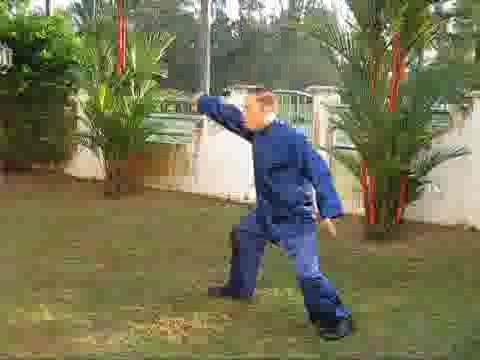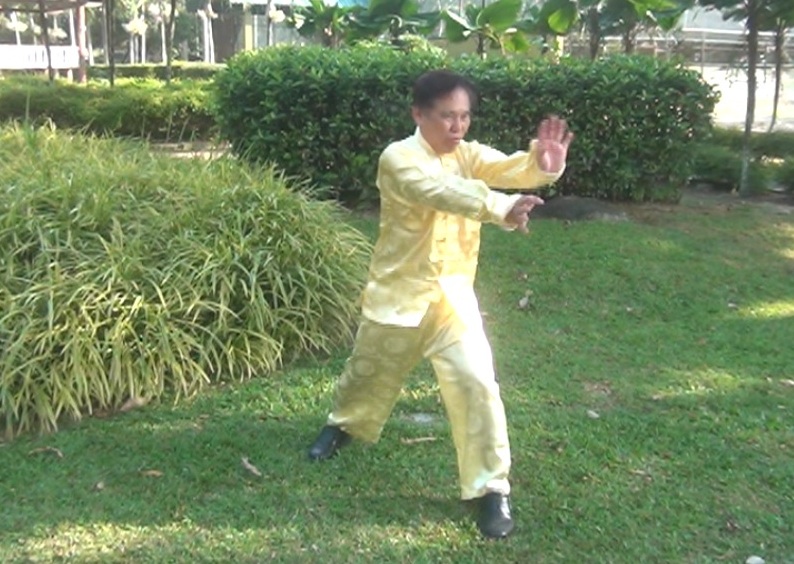WHY IS DRAGON-STRENGTH MY PINNACLE OF KUNGFU TRAINING?

Wudang Taijiquan
Question
If I am not mistaken I heard you mentioning in the Valentines Courses that: "Wudang Taijiquan represents the pinnacle of Shaolin Kungfu but Dragon Strength is my pinnacle". I would kindly ask if you could please explain, why Dragon Strength is your pinnacle?
Santiago
Answer
Firstly, I shall explain why Wudang Taijiquan represents the pinnacle of Shaolin Kungfu. Then I shall explain why Dragon Strength is my pinnacle.
Shaolin Kungfu was, and still is, practiced at three stages. At the first stage, students learned the physical forms of Shaolin Kungfu. This would take at least a few years. Then, if they were selected they would be taught energy cultivation, known as nei kung or internal art. After another few years, if they were lucky they would be taught mind cultivation, or meditation. Not many students, of course, had the opportunity to reach energy cultivation even if they practice for a long time. Fewer still had he chance to practice mind cultivation.
When Zhang San Feng practiced Shaolin Kungfu on Wudang Mountain after he had graduated from the Shaolin Temple in Henan in the 13th century, he integrated all the three stages into one. In other words, instead of practicing the physical movements of kungfu, energy cultivation and mind cultivation separately, he practiced all of them together at the same time. As he performed physical movements of kungfu, he simultaneously cultivated energy and mind. He also modified the hard and linear aspects of Shaolin Kungfu into softer and circular movements.
The style of kungfu Zhang San Feng practiced was called Wudang Shaolin Kungfu, to differentiate it from Henan Shaolin Kungfu at the Shaolin Temple. Later it was shortened to Wudang Kungfu. A few centuries later it was called Taijiquan, or Taiji Kungfu, when Chen Wang Ting employed Taiji concepts to explain the philosophy of this martial art. The style of Taijiquan practiced on Wudang Mountain , which was previously called Wudang Kungfu, is now called Wudang Taijiquan, to differentiate it from other styles of Taijiquan like Chen Style and Yang Style that developed later.
Zhang San Feng is honoured as the First Patriarch of internal martial arts, as he was the one to integrate internal cultivation into external martial arts. Before him, martial arts were practiced at a physical level. Advanced martial art masters might pursue internal cultivation, but they did so separately from their martial art training.
Hence today practitioners of Taijiquan and other internal martial arts like Baguzzhang and Xingyiquan cultivate energy and mind as soon as they learn the physical forms of their martial arts, if their arts are genuine. This is different from the many styles of Shaolin Kungfu, like Hoong Ka, Wing Choon, Choy-Li-Fatt, Praying Mantis and Eagle Claw, which are generally described as external martial arts, where practitioners perform their arts at a physical level, and have to practice separately if they wish to add any internal dimensions.
However, most of the internal arts today have lost their internal aspects; they are practiced as external forms. On the other hand, some external martial art masters have developed internal force from their external methods, often without their conscious knowing, due to their long years of dedicated practice. So, today we have an interesting situation where internal art masters have no internal force though they may talk about it, and external art masters possess remarkable internal force thought they may not know any internal training methods.
The integration of the physical, energy and mind into one unity represents the pinnacle of kungfu development. Kungfu was not just for combat, but also for health and spiritual cultivation.
The rise of kungfu development to its pinnacle was not just based on the cultivation of energy and mind. Even at a physical combative level, one can witness, if he is initiated into some depth in martial art, the development from straight-forward techniques of punching, kicking and blocking to sophisticated techniques of felling and chin-na.
For convenience, the development of Shaolin Kungfu may be divided into three stages – the beginning, the middle and the advanced. The beginning stage of Shaolin Kungfu development may be represented by Four Gates, where the combat functions of its patterns are quite obvious. The middle stage may be represented by Tantui, where its felling techniques may not be obvious to some martial artists. The advanced stage can be represented by Wudang Taijiquan, where even seasoned martial artists may think its effective combat techniques are flowery decorations just for show.
In combat, size, age and gender are decisive factors if one uses Shaolin Kungfu at its beginning stage of development, like using techniques from Four Gates, or even at its middle stage, like using techniques form Tantui. If you are muscular, young and male, you have a clear advantage when you ram a Black Tiger into a fragile, elderly woman, or use a waist-throw in Tantui to fell her. Reversely, if you are fragile, elderly and female, you would have difficulty to defend against these attacks.
But size, age and gender are not decisive factors if one uses Shaolin Kungfu at its advanced stage of development, like using techniques from Wudang Taijiquan. If you have internal force, which is a hallmark of Shaolin Kungfu at its advanced stage, it does not matter whether your opponent is muscular, young and male. But even without internal force, by just employing the mechanics of physical movements of this stage, a fragile, elderly woman can defeat a stronger, younger male opponent.
Instead of blocking his powerful punch head-on, she can gently brush off his attack by rotating her waist in the pattern, Shift Horse Ask Way, and plucking his peaches if she wants to. Instead of physically resist his throw, she can elegantly escapes to his back using Dark Dragon Wraps Body, striking the back of his head if she wishes.
Nevertheless, for me the pinnacle of my kungfu development was Dragon Strength. In fact, it was because of Dragon Strength that I was able to integrate physical movements in kungfu with energy cultivation and mind cultivation into one unity. All family members of Shaolin Wahnam Institute benefited much from this development. As a result of my integration of the physical, energy and mind in my Dragon Strength practice that all those who learned from me in Shaolin Wahnam could develop internal force and attained a one-pointed mind the very moment they learned kungfu or chi kung from me.
This did not happen when I taught in Shaolin Wahnam Association, the fore-runner of Shaolin Wahnam Institute. This was because my integration of physical forms, energy and mind happened after I started teaching in Shaolin Wahnam Association and before in Shaolin Wahnam Institute.
Students at Shaolin Wahnam Association, like students in all other kungfu schools including today’s so-called internal schools, first learned the physical forms of kungfu, then learned internal methods like One-Finger Shooting Zen, and later learned mind training in sitting meditation. Most students in other kungfu schools did not have any chance to learn internal force and mind cultivation, even when they practiced so-called internal arts.
When students of Shaolin Wahnam Association practiced Four Gates, the first kungfu set I taught to all students in the Association, they performed it at a physical level. They practiced One-Finger Shooting Zen separately. Before concluding the training session they practiced sitting meditation for mind training. There was no conscious effort to integrate the three aspects of physical forms, energy and mind into one unity.
When students of Shaolin Wahnam Institutue practiced Lohan Asks the Way, the first kungfu set I taught to all Shaolin students of our school, they performed it at all the three levels of the physical, energy and mind at the same time. Even if they had not trained other methods of energy cultivation and mind cultivation, like One-Finger Shooting Zen and sitting meditation, they would have internal force and mental clarity, the two desired results of energy cultivation and mind cultivation, by just practicing Lohan Asks the Way.
Nevertheless, my attempt to integrate physical form, energy and mind into one unity was inspired by reading Taijiquan classics. It was mentioned in some classics that the highest attainment in Taijiquan was to use mind to move energy, and to use energy to move form. A Taijiquan master of the highest level did not use muscles to perform his Taijiquan; he used his mind.
I applied this principle of mind moving energy moving form to Dragon Strength. The result was instantaneous and marvelous. I was amazed myself, though I was not surprised. My mind moved my energy, and my energy moved my form. You can have an idea of this remarkable attainment in this old video here.
I was not surprised because I had been practicing chi kung where I could use my mind to channel my chi to various parts of the body, and where I could use my thoughts to change the speed and directions of my chi flow. I reckoned that using mind to direct energy to direct form in set performance is just the next step, and I was confident in accomplishing this next step.
It was ridiculous but true that while some masters regarded using mind to direct chi to direct form as the highest attainment in Taijiquan, I could teach some students to accomplish this advanced skill in Intensive Taijiquan Courses. The webpage here gives an example.
This advanced skill has become standard in our school. It is one of the main reasons why we are so cost-effective, enabling our students to achieve in one year what past masters would need ten. On a lighter note, it has contributed to a joke that those who are smart would practice Taijiquan, learning at the start what would be taught at an advanced level in Shaolin Kungfu, whereas those who wanted the best and are willing to work hard for it prefer Shaolin Kungfu.
Arriving at the pinnacle with Dragon Strength has enabled me to attain peak performance in my kungfu as well as my daily life. If I were forced against my will into a challenge match, I am confident of defeating my opponent, and injuring him quite seriously too, as soon as he makes a move!
I had an impromptu confirmation of this skill many years ago. A few Shaolin Wahnam instructors and I had tea in a coffee shop in Costa Rica. I could not remember the topic of discussion, but I asked Piti who sat next to me to attack me in any way he liked.
Piti is not only big-sized and fast, he has a lot of internal force. Once he broke a rib of Dr Juan of San Jose with a vertical fist without even touching him! As soon as Piti moved to attack, I shot out my dragon-hand form at his throat. I did not touch Piti, but he later reported that he felt dazed. He had to perform Lifting the Sky to relieve the dim mark injury. Jeffrey, who sat directly opposite, witnessed all these happenings.
More significantly, arriving at the pinnacle of Dragon Strength has enriched my daily life remarkably. Many people have expressed amazement at the speed and number of tasks I can accomplish, despite my biological age and busy schedule.

Dragon Strength
Dragon Strength in Video
Old Version of Dragon Strength
Treasure House of Kungfu Sets
Treasure House of Combat Application
The questions and answers are reproduced from the thread 10 Questions on Dragon Strength in the Shaolin Wahnam Discussion Forum.
LINKS
